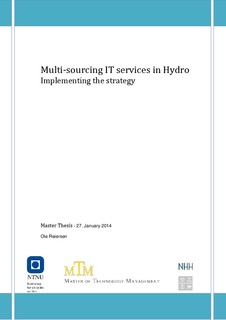| dc.description.abstract | Through recent years, multi-sourcing of IT services has become increasingly popular as a way for large companies to diversify their IT services deliveries, reduce costs, increase service quality and keep up with the technological development. For many of these companies, the ideal world of buying “best-of-bread” services from many different service providers has become more complex and costly than what they initially expected.
After changing to a multi-sourcing strategy for IT services in 2010, Hydro has been struggling with the performance of the new IT service stack configuration. In this master thesis I explore how large national and multi-national companies in general and Hydro in particular can be successful in operating basic IT infrastructure and application services based on a multi-sourcing strategy. This is done by researching the question “What are the internal requirements for Hydro to be successful in operating multi-sourced IT services based on the current service stack configuration?”
As the theoretical foundation for my research I use the Resource Based View (RBV) framework for internal company analysis. I strengthen this by supplementing with theory on how company internal factors can influence outsourcing contract complexity which again can affect operations under the outsourcing contracts, and theory on how organisational readiness can be assessed to find gaps in resource and capability needs.
This theory gives the foundation for an empirical exploratory case-study on the Hydro case, using data collection from unstructured interviews of key stakeholders in Hydro and three comparable companies. These fairly extensive interviews give valuable insight into general outsourcing and multi-sourcing experience. They also provide knowledge specifically useful when analysing the current problems in Hydro, seen from different points of view; local vs. central IT, local vs. central business users, infrastructure vs. application IT and procurement vs. IT.
The collected data form the basis for the case analysis based on pattern matching of common statements followed by a discussion were each statement is evaluated against both the theoretical input and the detailed information from the interviews. From this analysis the conclusion is that the following requirements are to be fulfilled in order to ensure that a multi-sourcing strategy is successful: - Ensure that there is sufficient in-house competence on all key infrastructure and applications.
- Establish central service integration function across infrastructure and applications.
- Make sure that system documentation exists and is available to the helpdesk and the service integration function.
- Establish a common helpdesk, controlled by the service, covering infrastructure and applications. | nb_NO |
